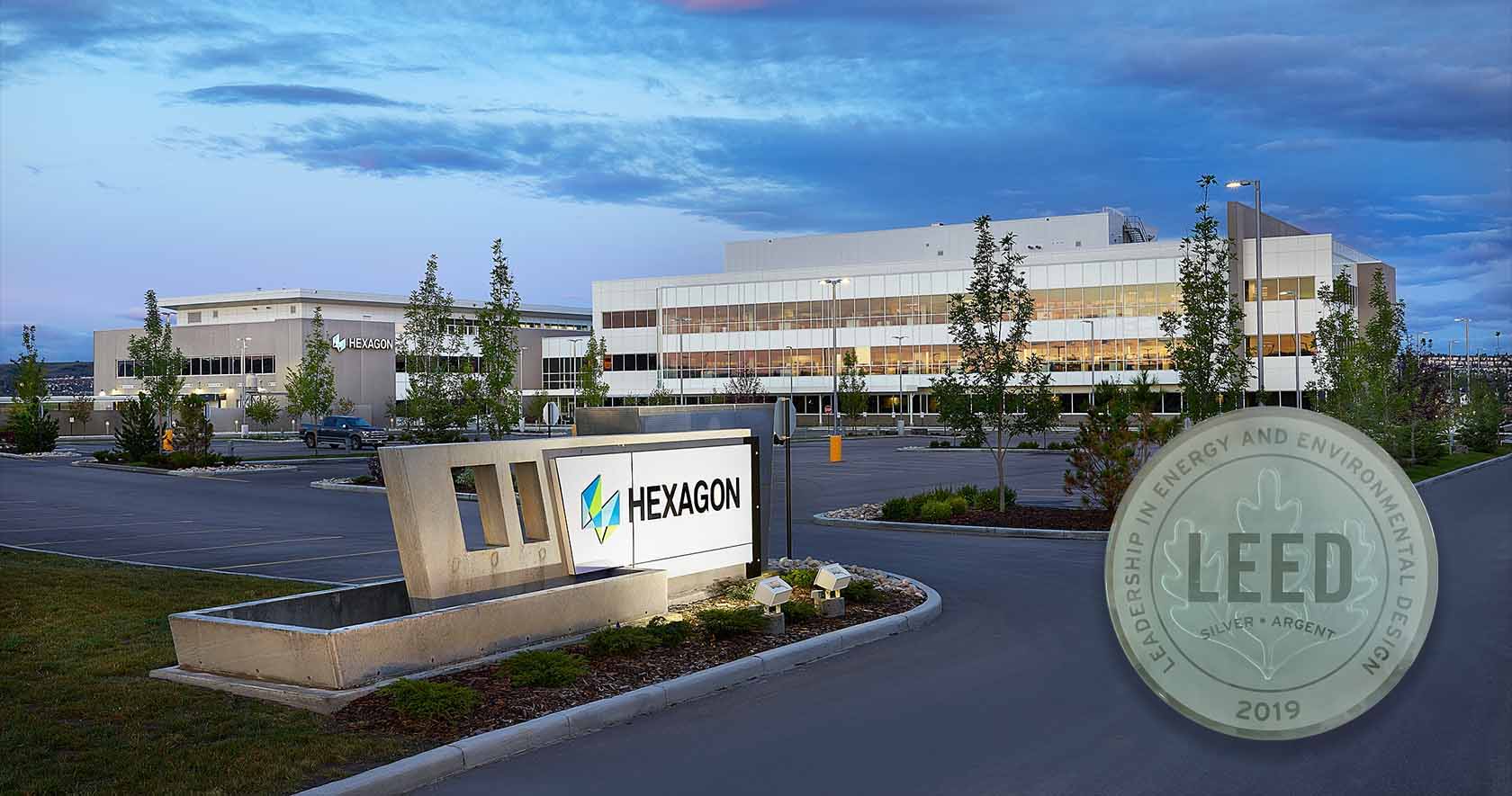Hexagon's Autonomy & Positioning division certifications
We look to trusted industry standards to minimise our environmental impact and demonstrate that commitment for our customers and are committed to continuous improvement of our product quality and safety. Learn how we are achieving this.
LEED® certification at the Hexagon Calgary Campus
 When designing the Hexagon Calgary Campus in Alberta, Canada, which serves as the headquarters for Hexagon’s Autonomy & Positioning division, we saw the unique opportunity to incorporate our sustainability goals by constructing a green building. We looked to the LEED® green building program, developed by the U.S. Green Building Council and used worldwide to guide the building’s design.
When designing the Hexagon Calgary Campus in Alberta, Canada, which serves as the headquarters for Hexagon’s Autonomy & Positioning division, we saw the unique opportunity to incorporate our sustainability goals by constructing a green building. We looked to the LEED® green building program, developed by the U.S. Green Building Council and used worldwide to guide the building’s design.
LEED® certification is a proven system that directly addresses climate change by encouraging the creation of resource-efficient buildings. It measures water efficiency, materials and resources, indoor environmental quality, innovation, location and transportation impacts on the environment.
Employees help drive environmental stewardship at Hexagon’s Autonomy & Positioning division through the Environmental Committee for the Calgary campus, which supports activities with positive environmental impact such as promoting recycling by designing office bin colours correspond with municipal garbage carts for employees to recognize and choose the appropriate bin more easily.
By achieving LEED® certification on our campus facilities, we demonstrate Hexagon’s commitment to sustainable operations. Our division’s headquarters include electric vehicle charging stations for employees and motion sensors to automatically turn off LED lights throughout the building when not occupied. The facility can be temperature controlled to cool the building without using air conditioning compressors with separate systems monitoring overall energy use floor by floor, section by section.
By monitoring our energy use, we actively reduce energy consumption in line with the Canadian standard for building energy performance, contributing to lower greenhouse gas (GHG) emissions.
Hexagon aims to achieve carbon neutrality in scope 1 and 2 emissions — those from sources directly controlled by a company (1) and those indirectly created by a company’s energy purchases (2) — by 2030. By 2050, Hexagon aims to achieve carbon neutrality across the whole value chain (scope 3, all emissions associated with a company’s activities). More details about those and other targets are available on Hexagon’s sustainability page.
ISO certifications
 Hexagon’s Autonomy & Positioning division strives to minimise the environmental impact of its business operations by adhering to internationally recognised sustainability standards, such as ISO 14001 certification. That framework for an effective environmental management system is designed to provide an assurance that certified companies are measuring and improving their environmental impact.
Hexagon’s Autonomy & Positioning division strives to minimise the environmental impact of its business operations by adhering to internationally recognised sustainability standards, such as ISO 14001 certification. That framework for an effective environmental management system is designed to provide an assurance that certified companies are measuring and improving their environmental impact.
We achieved ISO 14001 certification at our Hexagon Calgary Campus in Alberta, Canada, as well as our Hexagon | VERIPOS facility in Aberdeen, Scotland, U.K.
We provide innovative products, services and technology solutions that support our customers with ease of integration and an optimised return on investment. Likewise, we are committed to sustainable solutions for our own operations, such as:
- Meeting or exceeding applicable environmental laws and regulations
- Setting goals to continuously improve our processes, operations and product design for the purpose of reducing our environmental impact
- Measuring our impact on the environment to ensure we are meeting our targets
- Responsibly managing hazardous materials and reusing or recycling all byproducts from our operations
- Ensuring tools needed to minimise our impact on the environment are available and utilised
- Encouraging our suppliers and contractors to do the same
- Training our employees to ensure they are aware of their role in supporting this policy
Our environmental certifications show we’re serious about implementing these processes and transparent with the results.
Product quality and safety
The precision available from technology created by Hexagon’s Autonomy & Positioning division has long differentiated us from our competitors — our product quality has always been a top priority, and customers choose us for it. Our implementation of a sustainability strategy, however, gives us an opportunity to build upon our process-driven approach to continuous product quality improvement. Our commitment to product safety and quality is seen in aligning our systems and processes with quality standards such as IATF 16949 and safety standards such as ISO 26262. To demonstrate our commitment to principles outlined in Hexagon’s sustainability strategy and fulfill software quality framework requirements of IATF 16949, we adopted the quality model known as ASPICE — Automotive Software Performance Improvement and Capability dEtermination.
The Automotive SPICE model aligned with out processes because it is not just a software quality model; it’s a collection of best practices for systems engineering, verification/validation, project management and supplier monitoring, to name just a few areas directly applicable to our operations. ASPICE ultimately ensures the safety of end-users as they can rely on our quality solutions. Full details are available at www.automotivespice.com.
We completed the integration of ASPICE procedures at our Hexagon Calgary Campus in 2021 and now apply the ASPICE model to all new projects. With cross-functional teams in Canada, the United States of America, the United Kingdom and India, we also are working with our colleagues elsewhere in Hexagon’s Autonomy & Positioning division to adopt appropriate processes and frameworks.

“Our engineering systems and processes have long focused on continuous improvement, so the adoption of the Automotive SPICE quality model made sense for our organisation. Our customers increasingly expect adherence to industry quality standards, and Hexagon’s sustainability strategy makes it second nature for us to meet the most rigorous quality requirements for our products.”
— Jonathan Auld, Vice President of Engineering and Safety Critical Systems at Hexagon’s Autonomy & Positioning division
Responsible Business Alliance
At Hexagon’s Autonomy & Positioning division, we understand the social, environmental and ethical responsibilities of an interconnected global supply chain. To fulfill those responsibilities, we cooperate with our suppliers to be as transparent as possible about sourcing our raw materials. To expand upon the work we have already done in this area and help accomplish new goals, Hexagon joined the Responsible Business Alliance (RBA).
We aim to drive sustainable value across our supply chain and internal operations through RBA standards, policies, risk assessment platforms, audit tools, e-learning and more. Our support of RBA standards is an important step towards reaching Hexagon’s goal of conducting sustainability supplier audits on 100 percent of direct suppliers in risk areas by 2023.
Hexagon’s Autonomy & Positioning division has a history of responsibly sourcing components. We specifically monitor our supply chain for so-called “conflict minerals” — raw materials that directly or indirectly finance armed groups who violate human rights. As part of our due diligence in this area, we use the RMI Conflict Minerals Reporting Template (CMRT) and work with appropriate suppliers to complete CMRT declarations on the way to processing on an annual basis.

“We recognise our position in the global supply chain comes with more responsibilities than just making sure we have enough components and raw materials to build our own products. We can have a positive impact on the environment and societies around the world by examining our own practices through a lens of sustainability and encouraging our suppliers to do the same.”
— Isabel Murguia, Vice President of Operations at Hexagon’s Autonomy & Positioning division